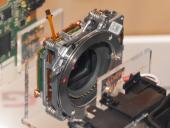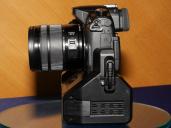
-
I think externally connected and recorded audio on a separate recorder/preamp is still the best solution for most people. Why invest a few grand in a huge brick that is limited to just that camera.
-
Yep. Also remember that all Japanese companies have only one goal now - profitability. They are ok to reduce volume, reduce sales. But sale more premium stuff with very high margins. Hence all constructive and feature sets.
Also, camera market is very similar to Earth atmosphere. It becomes sparse with price increases, and quite fast.
-
Has anybody seen this review yet? _eduardoangel.com/2014/02/07/4k-video-under-2k-panasonic-gh4/ you can also follow him on twitter, he still has a GH4 to play with.
-
Seems like specs from someone who really never touched camera with bunch of affiliate shit added instead of any review.
-
A shameful post really. I bet he hasn't the camera. It's full of ads of things he get paid.
He says.that the gh4 hasn't silent shooting...
-
Does anybody know if the screen info still disappears after 10 seconds? I have been reading as much as I can and can't find anything about it - really hope it is now a menu option...
-
Does anybody know if the screen info still disappears after 10 seconds? I have been reading as much as I can and can't find anything about it - really hope it is now a menu option...
As both EVF and screen are still OLED I have some doubts about any progress here.
-
"...I think externally connected and recorded audio on a separate recorder/preamp is still the best solution for most people. Why invest a few grand in a huge brick that is limited to just that camera..."
There seems to be some confusion about Timecode and the adapter. The adapter accepts Timecode from and external generator, usually a high-end audio recorder that outputs a stable clock that is then embedded in the video. And since the audio has the same Timecode, post sync is simple. So saying the "brick" is limited to just the camera is just stating the obvious (limited being the silly word). You wouldn't put it on an Olympus or other camera. And for those complaining about the size, go into a audio parts store and have a look at the size of a female XLR adapter. Then imagine two of them, four BNC connectors and a 4-pin XLR power adapter. I challenge anyone to make something smaller while still retaining functionality.
-
your sir has the best all around answer from all the thread.
-
Voldemort says the brick is the only way to get 422 10 bit out of the camera in 4k .... he goes on to say you can get 422 10 bit out of it via the micro hdmi but its limited to 1080p
-
I'm already tired of the bitching about this camera and it's not even a week yet. Seems to me that we've been given MUCH more than anticipated with the GH4. The brick has features in addition to what most expected and it's use is clearly not going to be for the majority of users. This is a specialty item and not just an XLR box.
People are complaining about the 100mbps and 8bit internal 4K recording without really seeing much evidence yet of what it's gonna look like or be like to work with. There's a LOOONG way to go in terms of learning about this camera, it's strengths and weaknesses. I think people are putting too much into the 4K hype and not really looking at the camera as a whole. The camera is the core of a very powerful system that can be small and light or with the Brick built up to be more of a studio production unit. Those are totally different worlds and yet the camera can live in both at a reasonable level. That's really a nice set of options.
-
Agreed, I think for me the most exciting bit of this camera is the 1080p modes.
-
10-bit 4:2:2 was what i was hoping for out of the box.
Don't know if anyone has mentioned this yet, but wouldn't down-scaling the 4k and UHD modes to 2k give you a 4:2:2 8-bit image? So in a way, I guess it would have internal 4:2:2 recording if you're only doing 1080p projects...
Or is 4k 4:2:0 actually equivalent to 2k 4:4:4 image?
-
@JohnTollwannabe in the old days I used to use timecode for the audio, but we did not edit in post, we just switched cams on the fly. So back then it certainly was handy. No drift, and right out the door. Maybe that was better! But now using more cams and doing much more work in post, I don't use it anymore. I'm not saying it isn't useful. I wouldn't turn it down if an easy format for it was available, because you get a precise lock for long events, but mainly I'm just syncing clips and audio as I go along. The other reason I don't use it is that I have cams at different distances so the have to be reclocked anyway, even if they are TC synced. You can use a superclock or a picosecond RME front end for the Tascam DR 680 and it won't drift, but of course your cam may drift. And drifting is annoying. Yup. But then you bump it along. If you clocked the 680, you could presumably daisy chain it (maybe a nightmare) to the GH4 TC in, but that's not what you are looking for I'm guessing. Maybe a neat solution will arrive in the aftermarket.
I do think that the fact that there are dedicated pins for some of this stuff means you are going to see for example an aftermarket breakout box for the XLRs, or a breakout cable for SDI. I'm assuming the P48 (which probably is P36 but whatever) is powered by the brick, so no joy there. I'm hoping the SDI is just a straight pinout, so you can plug in a ten dollar cable. Hope. You may even see mini bricks with batteries and some features--some of those pins may be for unknown options or they may be assignable in software or firmware.
-
There seems to be some confusion about Timecode and the adapter. The adapter accepts Timecode from and external generator, usually a high-end audio recorder that outputs a stable clock that is then embedded in the video. And since the audio has the same Timecode, post sync is simple.
Especially in a multi-camera situation.
-
-

 023.jpg799 x 600 - 352K
023.jpg799 x 600 - 352K
 039.jpg800 x 600 - 373K
039.jpg800 x 600 - 373K -
@bwhitz I'm no expert, but I think you're right that 4k 4:2:0 actually downscales to 1080p 4:4:4 which is cool and all, but I think it really demonstrates how silly it is to not have higher than 4:2:0 modes for 1080 in the cam.. This idea of yours sounds like a good idea to get quality 1080p 444, but you also get lower bitrate. Probably worth it in a few cases..?
-
@Aria that's a +20 ...
People have been complaining about specs that are still well above what we've got unless you wanna jump several thou is cash outlay. And besides ... not all "specs" are equal or even near equivalent. We'll have to wait until a final production version is out and run through the mill by a number of people to determine how much of a "jump" this camera represents.
I'm thinking it will be a significant and very usable jump, but of course that's as much speculation as anyone here. Patience ... people ...
-
(Ctrl)+(-) on your browser to a 50% view, make your own opinion :D
i think that the downscaling is going to be very popular on the GH4!

 Chroma-Examples.jpg600 x 600 - 75K
Chroma-Examples.jpg600 x 600 - 75K -
No sign of original files from that Yucatan vid eh? Either the grading or the white balance feels way off to me, so much so I can't even judge the camera (sooo blue at times).
Also, I (only half joking) say my slider shots on my @driftwood/VK gh2 from two years ago with a crappy 14mm pancake still win. ;-)
-
444 is nice over 420, but the limitation here is called 8bit. It worth get a recorder to have 10bit juice. 10bit 422 is waaaaay better than 8bit 444.
-
The wedding photographer's video was a little disappointing in video mode when be uses the steadycam around the couple. The sky is blown out which doesn't show a lot of promise for dynamic range. I know it's too early to say but that's what I see. If dynamic range is more important wouldn't the Black Magic cameras still win? Everyone is talking about sampling and resolution, but I really want the GH4 to improve dynamic range. Will it be 11 stops even, or closer to 10 at lower iso?
Howdy, Stranger!
It looks like you're new here. If you want to get involved, click one of these buttons!
Categories
- Topics List23,964
- Blog5,723
- General and News1,342
- Hacks and Patches1,151
- ↳ Top Settings33
- ↳ Beginners254
- ↳ Archives402
- ↳ Hacks News and Development56
- Cameras2,361
- ↳ Panasonic990
- ↳ Canon118
- ↳ Sony154
- ↳ Nikon96
- ↳ Pentax and Samsung70
- ↳ Olympus and Fujifilm99
- ↳ Compacts and Camcorders299
- ↳ Smartphones for video97
- ↳ Pro Video Cameras191
- ↳ BlackMagic and other raw cameras121
- Skill1,961
- ↳ Business and distribution66
- ↳ Preparation, scripts and legal38
- ↳ Art149
- ↳ Import, Convert, Exporting291
- ↳ Editors191
- ↳ Effects and stunts115
- ↳ Color grading197
- ↳ Sound and Music280
- ↳ Lighting96
- ↳ Software and storage tips267
- Gear5,414
- ↳ Filters, Adapters, Matte boxes344
- ↳ Lenses1,579
- ↳ Follow focus and gears93
- ↳ Sound498
- ↳ Lighting gear314
- ↳ Camera movement230
- ↳ Gimbals and copters302
- ↳ Rigs and related stuff272
- ↳ Power solutions83
- ↳ Monitors and viewfinders339
- ↳ Tripods and fluid heads139
- ↳ Storage286
- ↳ Computers and studio gear560
- ↳ VR and 3D248
- Showcase1,859
- Marketplace2,834
- Offtopic1,319
Tags in Topic
- gh4 280












